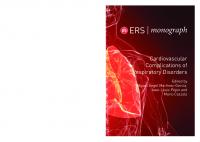Cardiovascular Complications of COVID-19: Acute and Long-Term Impacts (Contemporary Cardiology) 9783031154775, 9783031154782, 3031154770
This book is the first comprehensive approach on COVID-19 cardiac complications, both during the acute phase as well as
154 100 5MB
English Pages 452 [434]
Table of contents :
Foreword
Preface
Acknowledgments
Contents
Part I: General Part
Chapter 1: Biology of SARS-CoV-2 Coronavirus; Origin, Structure, and Variants
Introduction
Method of Search
The SARS-CoV-2 Biology
The SARS-CoV-2 Origins
HCoV-229E
HCoV-OC43
SARS-CoV
HCoV-NL63
HCoV-HKU1
MERS-CoV
SARS-CoV-2
The SARS-CoV-2 Structure
SARS-CoV-2 Variants
Conclusion
References
Chapter 2: COVID-19 Epidemiology and Differences in Incidence and Mortality Between Countries
Origins
Asian Countries
COVID-19 in the United States of America
Canada
Mexico
Peru
Brazil
Colombia
Europe
Russia
Ukraine
Italy
Poland
South Africa
Antarctica
References
Chapter 3: Clinical Symptoms and Course of COVID-19
SARS-CoV-2 Transmission
Virus Replication
Immunological Responses and Cytokine Storm (CS)
Virus Variants and Associated Evolution in the Clinical Course
Clinical Stages of COVID-19 [21]
Mild and Asymptomatic Stage
Symptomatic Stage
Severe Disease
Acute Respiratory Distress Syndrome/Critical Stage
Clinical Symptoms of COVID-19
General Symptoms in the Early, Asymptomatic and Mild Infection
Respiratory Manifestations
Extra-Respiratory Manifestations
Hematologic Abnormalities
Prothrombotic Events
Cardiovascular Involvement
Neurological and Neuropsychiatric Manifestations
Kidney Involvement
Gastrointestinal and Hepatic Involvement
Skin Associated COVID-19 Symptoms
COVID-19 in Children
Long COVID-19
Conclusions
References
Chapter 4: Risk Factors of Developing COVID-19 and its Severe Course
COVID-19 and Related Cardiovascular Risk Factors
Age
Sex
Smoking
Diabetes
Obesity
Hypertension
Dyslipidemia
Chronic Kidney Disease
Additional Markers of Increased CV Disease Risk in COVID-19
References
Chapter 5: Prognosis in COVID-19 Patients: Statistics, Risk Factors
Introduction
Demographic Features
Age and Sex
Ethnicity
Clinical Symptoms
Comorbidities and the Course of COVID-19
Hypertension
Diabetes Mellitus
Obesity
Chronic Obstructive Pulmonary Disease (COPD)
Chronic Kidney Disease
Cancer
Special Conditions and Populations of Patients and the COVID-19 Course
Smoking
Pregnancy
Children
Selected Laboratory Parameters Values and the COVID-19 Course
Leukocyte Counts
Lymphocyte Counts
Neutrophil Counts
Platelet Counts
C-Reactive Protein (CRP)
Procalcitonin (PCT)
Lactate Dehydrogenase (LDH)
Interleukin 6 (IL-6)
D-Dimer
Ferritin
Albumin
Aspartate Aminotransferase (AST) and Alanine Aminotransferase (ALT)
Cardiac Troponin
Complications
Reinfection
Conclusions and Take-Home Message
References
Part II: Cardiovascular Complications of the Acute Phase of COVID-19
Chapter 6: Myocardial Injury in COVID-19 (Epidemiology, Influence on Prognosis, Pathogenesis, Treatment)
Introduction
Definition of COVID-19 Induced Myocardial Injury
Epidemiology
Pathogenesis of Myocardial Injury in COVID-19 Patients
Biomarkers Assessment of Myocardial Injury
Cardiac Troponin
Myocardial and Systemic Inflammation
Other Biomarkers
Paraclinical Assessment of Myocardial Injury
ECG
Cardiac Ultrasound
Coronary Angiography
Computed Tomography Angiography (CTA)
Cardiac MRI
Follow-Up and Treatment
Prognosis
Conclusions
References
Chapter 7: Acute Coronary Syndrome: Destabilization of Atherosclerotic Plaque in COVID-19 (Epidemiology, Influence on Prognosis, Pathogenesis, and Treatment)
COVID-19: Short Clinical Characteristics Through the Prism of Cardiology
Epidemiology and Risk of ACS During SARS-CoV-2 Infection
ACS During SARS-CoV-2 Infection and Prognosis
Pathogenesis of ACS Induced by SARS-CoV-2 Infection
Diagnostics and Treatment Aspects
STEMI: ESC Guidance for the Diagnosis and Management of Cardiovascular Disease During the COVID-19 Pandemic [101]
NSTEMI: ESC Guidance for the Diagnosis and Management of Cardiovascular Disease During the COVID-19 Pandemic [101]
ACS Prevention
Conclusions
References
Chapter 8: Acute Vascular Injury in COVID-19
Introduction
Pathophysiology
Clinical Presentation
Respiratory
Cardiovascular
Central Nervous System
Gastrointestinal
Renal
Dermatological
Systemic Vasculitis
Vaccine-Related Complications
Treatment
Anticoagulation
Acute Coronary Syndrome
Ischemic Stroke
Venous Thromboembolism, DVT, and PE
Acute Limb Ischemia
Prophylaxis
Anticoagulation
Anti-Inflammatory Therapies
Statins
RAAS Inhibition
Conclusion
References
Chapter 9: Heart Failure and Acute Circulatory Failure in COVID-19 (Epidemiology, Influence on Prognosis, Pathogenesis, Treatment)
Epidemiology
Influence on Prognosis
Pre-existing HF
New Onset of HF
Cardiogenic Shock
Pathogenesis
Direct Injury
Systemic Inflammation
Hypoxic Injury
Endothelial Dysfunction-Induced Coagulation Disorders
Treatment
Chronic Heart Failure Treatment
Acute Heart Failure Treatment
References
Chapter 10: Cardiomyopathy in COVID-19 (Epidemiology, Influence on Prognosis, Pathogenesis, Treatment)
Introduction
Heart Failure, Cardiomyopathies and COVID-19
Stress-Induced Cardiomyopathy and COVID-19
Dilated Cardiomyopathy and COVID-19
Hypertrophic Cardiomyopathy
Restrictive Cardiomyopathy and Arrhythmogenic Right Ventricular Cardiomyopathy in COVID-19
Cardiomyopathies and COVID-19 Vaccines
Summary
References
Chapter 11: Arrhythmias in COVID-19
Epidemiology
Influence on Prognosis
Pathogenesis
Treatment
References
Chapter 12: Thromboembolic Events in COVID-19
Epidemiology
Pathogenesis
The Diagnosis of VTE in COVID-19
Treatment
Thromboprophylaxis in Patients with COVID-19
Influence on Prognosis
Conclusions
References
Chapter 13: Stroke in COVID-19
Introduction
Ischemic Stroke (IS) and Transient Ischemic Attack (TIA) in COVID-19 Pandemic
Epidemiology of IS and TIA During COVID-19 Pandemic
Description of IS in COVID-19 Positive Patients
Clinical, Etiological, and Imaging Features of COVID-19 Positive IS Patients
Management of COVID-19 Positive Patients with IS
Outcome of COVID-19 Positive Patients with IS
Pathogenesis
Conclusions
Hemorrhagic Stroke (HS) in COVID-19 Pandemic
Epidemiology of HS During COVID-19 Pandemic
Intracerebral Hemorrhage (ICH)
Clinical Features of ICH in COVID-19 Positive Patients
Comorbidities of COVID-19 Positive Patients with ICH
Management of COVID-19 Positive Patients with ICH
Course and Outcome of HS in COVID-19 Positive Patients
Pathogenesis
Conclusion
Subarachnoid Hemorrhage (SAH) in COVID-19 Pandemic
Epidemiology During COVID-19 Pandemic
Clinical Features of COVID-19 Positive SAH Patients
Course and Outcome of COVID-19 Positive Patients with SAH
Pathogenesis
Conclusion
Cerebral Venous Thrombosis (CVT) in COVID-19 Positive Patients
Epidemiology of CVT During COVID-19 Pandemic
Clinical Features of CVT in COVID-19 Positive Patients
Course and Outcome of CVT in COVID-19 Positive Patients
Pathogenesis
Conclusion
References
Chapter 14: Pulmonary Embolism After COVID-19 (Epidemiology, Influence on Prognosis, Pathogenesis, Treatment)
Introduction
Epidemiology
Incidence, Risk Factors
Pathogenesis
Thromboembolic Event Prevention and Management in COVID-19 Pneumonia Patients
Prophylactic Anticoagulation in Severe Hospitalized Patients
Prophylactic Anticoagulation in Mild to Moderate Patients
Prophylactic Treatment in Outpatient
Anticoagulation After Discharge from COVID-19 Hospitalization
Therapeutic Anticoagulation of Incident Thromboembolism Event
Medium- and Long-Term Prognosis After a Venous Thrombotic Event
Conclusion
References
Chapter 15: Interaction of Anti-COVID-19 Drugs with Cardiovascular Therapy
Statins
β-Blockers
Antihypertensive Drugs
Natural Drugs
References
Part III: Influence of the Treatment of Cardiovascular Diseases on the Course of COVID-19
Chapter 16: Beyond the Vaccines-Bioactive Lipids in COVID-19
Introduction
Bioactive Lipids LA and AA Can Inactivate SARS-CoV-2
Immunocytes and AA
M1 and M2 Macrophages and Lipids
Interaction(s) Among Desaturases, COX, LOX, n-3, and n-6 Fatty Acids and Their Metabolites and Cytokines
PGE2 and LXA4 Interact with each Other to Control Inflammation and Its Resolution
Conclusions and Therapeutic Implications
References
Chapter 17: Statins and COVID-19 (Mechanism of Action, Effect on Prognosis)
Statins and COVID-19: Mechanism of Action
Direct Effect of Statins
Indirect Effect of Statins
Statins and COVID-19: Effect on Prognosis
COVID-19 and Familial Hypercholesterolemia
References
Chapter 18: COVID-19 and Antihypertensive Treatment
Introduction
COVID-19 and Hypertension
COVID-19 and Antihypertensive Drug Treatment
Study Limitations
Blood Pressure Values, Blood Pressure Control, and COVID-19 Pandemic
COVID-19 and Hypertension Guidelines
References
Chapter 19: Colchicine in COVID-19 (Mechanism of Action, Effect on Prognosis)
Introduction
COVID-19 and the Role of Inflammation
Colchicine
Mechanism of Action
Colchicine Pharmacokinetics
Impact of Colchicine on Mortality and Morbidity on COVID-19
Role of Colchicine in Cardiac Protection
Colchicine Dosage for Cardioprotection in Patients with COVID-19
Role of Colchicine in Glycemic Level
Role of Colchicine on Furin Level
Conclusions
References
Chapter 20: Antiplatelet Drugs in COVID-19: Mechanism of Action and Effect on Prognosis
Introduction
Thrombosis in COVID-19: Pathophysiological Perspectives
Platelets in COVID-19
Thrombosis in COVID-19: Clinical Perspectives
Aspirin in COVID-19
Anti-thrombotic Effects of Aspirin
Anti-inflammatory Effects of Aspirin
Anti-viral Effects of Aspirin
Mechanism of Action of Other Antiplatelets in COVID-19 Disease
Clinical Studies of Aspirin in COVID-19
Aspirin in Patients with COVID-19 in the Community
Trials of Other Antiplatelet Drugs
Future Trials
Conclusion
References
Chapter 21: Antidiabetic Drugs in COVID-19
Introduction
Metformin
Sulfonylureas (SUs)
Pioglitazone
Dipeptidyl Peptidase 4 Inhibitors (DPP4i)
Glucagon-Like Peptide-1 Receptor Agonists (GLP-1 RAs)
Sodium-Glucose Co-transporter 2 Inhibitors (SGLT2i)
Insulin
Conclusions
References
Part IV: Cardiovascular Complications on Long COVID-19
Chapter 22: Long-COVID-19: Definition, Epidemiology, and Clinical Implications
Introduction
Biological and Historical Context
Definitions of Long-COVID
Symptoms and Pathophysiological Mechanisms in Long-COVID
Epidemiology of Long-COVID
Clinical Implications of Long-COVID
Conclusions and Future Directions
References
Chapter 23: Cardiovascular Complications of Long COVID-19: Prevalence, Diagnosis, and Risk Factors
Introduction
Long COVID-19 Epidemiology
Risk Factors for Developing Severe and Long-Lasting COVID-19
Characteristic Symptoms of Long COVID-19
Overview of Long COVID-19 Symptoms and Possible Mechanisms Leading to Their Development
Mechanisms Underlying Cardiovascular Damage in Long COVID-19
The Effect of Long COVID-19 on the Heart Muscle
The Effect of Long COVID-19 on Blood Vessels
Diagnosis and Treatment of Cardiovascular Effects in Long COVID-19
References
Chapter 24: Cardiovascular Complications of Long-COVID: Management
Introduction
Review of Original Studies
Review of Guidelines
Management
Heart Failure
Coronary Artery Disease
Arrhythmia
Myocarditis
Venous Thromboembolism
Conclusions
References
Part V: The Impact of COVID-19 Pandemic on the e-Services and Digital Tools Development in Medicime
Chapter 25: The Impact of the COVID-19 Pandemic on e-Services and Digital Tools Development in Medicine
Introduction
COVID-19 as a Catalyst for Research and Innovation on, and Uptake of, Digital Tools
Digital Tools for Tracking
Digital Tools for Infection Screening
Digital Tools for Contact Tracing
Digital Tools for Quarantine and Self-Isolation
Digital Tools for Clinical Monitoring
Discussion and Future Perspectives
References
Index
Foreword
Preface
Acknowledgments
Contents
Part I: General Part
Chapter 1: Biology of SARS-CoV-2 Coronavirus; Origin, Structure, and Variants
Introduction
Method of Search
The SARS-CoV-2 Biology
The SARS-CoV-2 Origins
HCoV-229E
HCoV-OC43
SARS-CoV
HCoV-NL63
HCoV-HKU1
MERS-CoV
SARS-CoV-2
The SARS-CoV-2 Structure
SARS-CoV-2 Variants
Conclusion
References
Chapter 2: COVID-19 Epidemiology and Differences in Incidence and Mortality Between Countries
Origins
Asian Countries
COVID-19 in the United States of America
Canada
Mexico
Peru
Brazil
Colombia
Europe
Russia
Ukraine
Italy
Poland
South Africa
Antarctica
References
Chapter 3: Clinical Symptoms and Course of COVID-19
SARS-CoV-2 Transmission
Virus Replication
Immunological Responses and Cytokine Storm (CS)
Virus Variants and Associated Evolution in the Clinical Course
Clinical Stages of COVID-19 [21]
Mild and Asymptomatic Stage
Symptomatic Stage
Severe Disease
Acute Respiratory Distress Syndrome/Critical Stage
Clinical Symptoms of COVID-19
General Symptoms in the Early, Asymptomatic and Mild Infection
Respiratory Manifestations
Extra-Respiratory Manifestations
Hematologic Abnormalities
Prothrombotic Events
Cardiovascular Involvement
Neurological and Neuropsychiatric Manifestations
Kidney Involvement
Gastrointestinal and Hepatic Involvement
Skin Associated COVID-19 Symptoms
COVID-19 in Children
Long COVID-19
Conclusions
References
Chapter 4: Risk Factors of Developing COVID-19 and its Severe Course
COVID-19 and Related Cardiovascular Risk Factors
Age
Sex
Smoking
Diabetes
Obesity
Hypertension
Dyslipidemia
Chronic Kidney Disease
Additional Markers of Increased CV Disease Risk in COVID-19
References
Chapter 5: Prognosis in COVID-19 Patients: Statistics, Risk Factors
Introduction
Demographic Features
Age and Sex
Ethnicity
Clinical Symptoms
Comorbidities and the Course of COVID-19
Hypertension
Diabetes Mellitus
Obesity
Chronic Obstructive Pulmonary Disease (COPD)
Chronic Kidney Disease
Cancer
Special Conditions and Populations of Patients and the COVID-19 Course
Smoking
Pregnancy
Children
Selected Laboratory Parameters Values and the COVID-19 Course
Leukocyte Counts
Lymphocyte Counts
Neutrophil Counts
Platelet Counts
C-Reactive Protein (CRP)
Procalcitonin (PCT)
Lactate Dehydrogenase (LDH)
Interleukin 6 (IL-6)
D-Dimer
Ferritin
Albumin
Aspartate Aminotransferase (AST) and Alanine Aminotransferase (ALT)
Cardiac Troponin
Complications
Reinfection
Conclusions and Take-Home Message
References
Part II: Cardiovascular Complications of the Acute Phase of COVID-19
Chapter 6: Myocardial Injury in COVID-19 (Epidemiology, Influence on Prognosis, Pathogenesis, Treatment)
Introduction
Definition of COVID-19 Induced Myocardial Injury
Epidemiology
Pathogenesis of Myocardial Injury in COVID-19 Patients
Biomarkers Assessment of Myocardial Injury
Cardiac Troponin
Myocardial and Systemic Inflammation
Other Biomarkers
Paraclinical Assessment of Myocardial Injury
ECG
Cardiac Ultrasound
Coronary Angiography
Computed Tomography Angiography (CTA)
Cardiac MRI
Follow-Up and Treatment
Prognosis
Conclusions
References
Chapter 7: Acute Coronary Syndrome: Destabilization of Atherosclerotic Plaque in COVID-19 (Epidemiology, Influence on Prognosis, Pathogenesis, and Treatment)
COVID-19: Short Clinical Characteristics Through the Prism of Cardiology
Epidemiology and Risk of ACS During SARS-CoV-2 Infection
ACS During SARS-CoV-2 Infection and Prognosis
Pathogenesis of ACS Induced by SARS-CoV-2 Infection
Diagnostics and Treatment Aspects
STEMI: ESC Guidance for the Diagnosis and Management of Cardiovascular Disease During the COVID-19 Pandemic [101]
NSTEMI: ESC Guidance for the Diagnosis and Management of Cardiovascular Disease During the COVID-19 Pandemic [101]
ACS Prevention
Conclusions
References
Chapter 8: Acute Vascular Injury in COVID-19
Introduction
Pathophysiology
Clinical Presentation
Respiratory
Cardiovascular
Central Nervous System
Gastrointestinal
Renal
Dermatological
Systemic Vasculitis
Vaccine-Related Complications
Treatment
Anticoagulation
Acute Coronary Syndrome
Ischemic Stroke
Venous Thromboembolism, DVT, and PE
Acute Limb Ischemia
Prophylaxis
Anticoagulation
Anti-Inflammatory Therapies
Statins
RAAS Inhibition
Conclusion
References
Chapter 9: Heart Failure and Acute Circulatory Failure in COVID-19 (Epidemiology, Influence on Prognosis, Pathogenesis, Treatment)
Epidemiology
Influence on Prognosis
Pre-existing HF
New Onset of HF
Cardiogenic Shock
Pathogenesis
Direct Injury
Systemic Inflammation
Hypoxic Injury
Endothelial Dysfunction-Induced Coagulation Disorders
Treatment
Chronic Heart Failure Treatment
Acute Heart Failure Treatment
References
Chapter 10: Cardiomyopathy in COVID-19 (Epidemiology, Influence on Prognosis, Pathogenesis, Treatment)
Introduction
Heart Failure, Cardiomyopathies and COVID-19
Stress-Induced Cardiomyopathy and COVID-19
Dilated Cardiomyopathy and COVID-19
Hypertrophic Cardiomyopathy
Restrictive Cardiomyopathy and Arrhythmogenic Right Ventricular Cardiomyopathy in COVID-19
Cardiomyopathies and COVID-19 Vaccines
Summary
References
Chapter 11: Arrhythmias in COVID-19
Epidemiology
Influence on Prognosis
Pathogenesis
Treatment
References
Chapter 12: Thromboembolic Events in COVID-19
Epidemiology
Pathogenesis
The Diagnosis of VTE in COVID-19
Treatment
Thromboprophylaxis in Patients with COVID-19
Influence on Prognosis
Conclusions
References
Chapter 13: Stroke in COVID-19
Introduction
Ischemic Stroke (IS) and Transient Ischemic Attack (TIA) in COVID-19 Pandemic
Epidemiology of IS and TIA During COVID-19 Pandemic
Description of IS in COVID-19 Positive Patients
Clinical, Etiological, and Imaging Features of COVID-19 Positive IS Patients
Management of COVID-19 Positive Patients with IS
Outcome of COVID-19 Positive Patients with IS
Pathogenesis
Conclusions
Hemorrhagic Stroke (HS) in COVID-19 Pandemic
Epidemiology of HS During COVID-19 Pandemic
Intracerebral Hemorrhage (ICH)
Clinical Features of ICH in COVID-19 Positive Patients
Comorbidities of COVID-19 Positive Patients with ICH
Management of COVID-19 Positive Patients with ICH
Course and Outcome of HS in COVID-19 Positive Patients
Pathogenesis
Conclusion
Subarachnoid Hemorrhage (SAH) in COVID-19 Pandemic
Epidemiology During COVID-19 Pandemic
Clinical Features of COVID-19 Positive SAH Patients
Course and Outcome of COVID-19 Positive Patients with SAH
Pathogenesis
Conclusion
Cerebral Venous Thrombosis (CVT) in COVID-19 Positive Patients
Epidemiology of CVT During COVID-19 Pandemic
Clinical Features of CVT in COVID-19 Positive Patients
Course and Outcome of CVT in COVID-19 Positive Patients
Pathogenesis
Conclusion
References
Chapter 14: Pulmonary Embolism After COVID-19 (Epidemiology, Influence on Prognosis, Pathogenesis, Treatment)
Introduction
Epidemiology
Incidence, Risk Factors
Pathogenesis
Thromboembolic Event Prevention and Management in COVID-19 Pneumonia Patients
Prophylactic Anticoagulation in Severe Hospitalized Patients
Prophylactic Anticoagulation in Mild to Moderate Patients
Prophylactic Treatment in Outpatient
Anticoagulation After Discharge from COVID-19 Hospitalization
Therapeutic Anticoagulation of Incident Thromboembolism Event
Medium- and Long-Term Prognosis After a Venous Thrombotic Event
Conclusion
References
Chapter 15: Interaction of Anti-COVID-19 Drugs with Cardiovascular Therapy
Statins
β-Blockers
Antihypertensive Drugs
Natural Drugs
References
Part III: Influence of the Treatment of Cardiovascular Diseases on the Course of COVID-19
Chapter 16: Beyond the Vaccines-Bioactive Lipids in COVID-19
Introduction
Bioactive Lipids LA and AA Can Inactivate SARS-CoV-2
Immunocytes and AA
M1 and M2 Macrophages and Lipids
Interaction(s) Among Desaturases, COX, LOX, n-3, and n-6 Fatty Acids and Their Metabolites and Cytokines
PGE2 and LXA4 Interact with each Other to Control Inflammation and Its Resolution
Conclusions and Therapeutic Implications
References
Chapter 17: Statins and COVID-19 (Mechanism of Action, Effect on Prognosis)
Statins and COVID-19: Mechanism of Action
Direct Effect of Statins
Indirect Effect of Statins
Statins and COVID-19: Effect on Prognosis
COVID-19 and Familial Hypercholesterolemia
References
Chapter 18: COVID-19 and Antihypertensive Treatment
Introduction
COVID-19 and Hypertension
COVID-19 and Antihypertensive Drug Treatment
Study Limitations
Blood Pressure Values, Blood Pressure Control, and COVID-19 Pandemic
COVID-19 and Hypertension Guidelines
References
Chapter 19: Colchicine in COVID-19 (Mechanism of Action, Effect on Prognosis)
Introduction
COVID-19 and the Role of Inflammation
Colchicine
Mechanism of Action
Colchicine Pharmacokinetics
Impact of Colchicine on Mortality and Morbidity on COVID-19
Role of Colchicine in Cardiac Protection
Colchicine Dosage for Cardioprotection in Patients with COVID-19
Role of Colchicine in Glycemic Level
Role of Colchicine on Furin Level
Conclusions
References
Chapter 20: Antiplatelet Drugs in COVID-19: Mechanism of Action and Effect on Prognosis
Introduction
Thrombosis in COVID-19: Pathophysiological Perspectives
Platelets in COVID-19
Thrombosis in COVID-19: Clinical Perspectives
Aspirin in COVID-19
Anti-thrombotic Effects of Aspirin
Anti-inflammatory Effects of Aspirin
Anti-viral Effects of Aspirin
Mechanism of Action of Other Antiplatelets in COVID-19 Disease
Clinical Studies of Aspirin in COVID-19
Aspirin in Patients with COVID-19 in the Community
Trials of Other Antiplatelet Drugs
Future Trials
Conclusion
References
Chapter 21: Antidiabetic Drugs in COVID-19
Introduction
Metformin
Sulfonylureas (SUs)
Pioglitazone
Dipeptidyl Peptidase 4 Inhibitors (DPP4i)
Glucagon-Like Peptide-1 Receptor Agonists (GLP-1 RAs)
Sodium-Glucose Co-transporter 2 Inhibitors (SGLT2i)
Insulin
Conclusions
References
Part IV: Cardiovascular Complications on Long COVID-19
Chapter 22: Long-COVID-19: Definition, Epidemiology, and Clinical Implications
Introduction
Biological and Historical Context
Definitions of Long-COVID
Symptoms and Pathophysiological Mechanisms in Long-COVID
Epidemiology of Long-COVID
Clinical Implications of Long-COVID
Conclusions and Future Directions
References
Chapter 23: Cardiovascular Complications of Long COVID-19: Prevalence, Diagnosis, and Risk Factors
Introduction
Long COVID-19 Epidemiology
Risk Factors for Developing Severe and Long-Lasting COVID-19
Characteristic Symptoms of Long COVID-19
Overview of Long COVID-19 Symptoms and Possible Mechanisms Leading to Their Development
Mechanisms Underlying Cardiovascular Damage in Long COVID-19
The Effect of Long COVID-19 on the Heart Muscle
The Effect of Long COVID-19 on Blood Vessels
Diagnosis and Treatment of Cardiovascular Effects in Long COVID-19
References
Chapter 24: Cardiovascular Complications of Long-COVID: Management
Introduction
Review of Original Studies
Review of Guidelines
Management
Heart Failure
Coronary Artery Disease
Arrhythmia
Myocarditis
Venous Thromboembolism
Conclusions
References
Part V: The Impact of COVID-19 Pandemic on the e-Services and Digital Tools Development in Medicime
Chapter 25: The Impact of the COVID-19 Pandemic on e-Services and Digital Tools Development in Medicine
Introduction
COVID-19 as a Catalyst for Research and Innovation on, and Uptake of, Digital Tools
Digital Tools for Tracking
Digital Tools for Infection Screening
Digital Tools for Contact Tracing
Digital Tools for Quarantine and Self-Isolation
Digital Tools for Clinical Monitoring
Discussion and Future Perspectives
References
Index

- Author / Uploaded
- Maciej Banach (editor)



![Management of Acute Coronary Syndromes. Contemporary Cardiology [1 ed.]
9781588291554, 1-58829-155-3](https://ebin.pub/img/200x200/management-of-acute-coronary-syndromes-contemporary-cardiology-1nbsped-9781588291554-1-58829-155-3.jpg)
![Diabetes and Cardiovascular Disease (Contemporary Cardiology) [3rd ed. 2023]
3031131762, 9783031131769](https://ebin.pub/img/200x200/diabetes-and-cardiovascular-disease-contemporary-cardiology-3rd-ed-2023-3031131762-9783031131769.jpg)


![The ESC Textbook of Intensive and Acute Cardiovascular Care [3 ed.]
0198849346, 9780198849346](https://ebin.pub/img/200x200/the-esc-textbook-of-intensive-and-acute-cardiovascular-care-3nbsped-0198849346-9780198849346.jpg)
